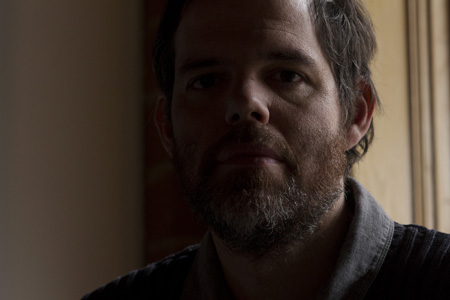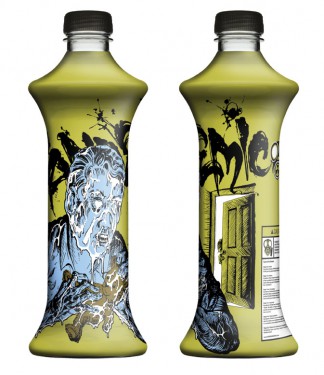 Back to selection
Back to selection
Culture Hacker: A Storytelling Pandemic

When the phone rings I’m feeling a bit nervous. The voice on the other end is slow and calculated.
“We can do 30,000 but it will take 10 weeks. In order to get it in time for Sundance we need to order 500,000 and ship from China… We’re going to have to find another way.” Not quite your normal Sundance prep conversation, especially when the items in question are bottles of water. But these are not regular bottles of water. They are “Pandemic Water,” just one entry point within a story-world experience entitled Pandemic 1.0 taking place at the 2011 Sundance Film Festival.
Pandemic 1.0 is a story R&D (research and development) project, the first step in a larger transmedia build that includes film, mobile, online and real-world events. This transmedia extension is set within the same story world as a feature film that I co-wrote and will be directing called HiM — a Lord of the Flies-style tale about a strange sleep virus that only affects adults and leaves the youth fighting for their lives.
Over a period of 120 hours, Pandemic 1.0 unfolds in a mixture of online and offline events. Festival attendees and those just viewing online are able to interact through a “social experiment,” one that harnesses various social and emerging technologies to impact the spread of a pandemic. How people choose to respond and collaborate will directly affect whether the pandemic spreads or slows. It is all part of a larger R&D effort that looks at the role of social behavior and its impact on storytelling.
The intention of employing a story R&D approach to the project is to experiment, review and refine. Not too dissimilar to how software is developed or how a script goes through revisions and receives feedback, the concept of story R&D provides insight into ways to design stories that resonant in a connected world. As storytelling moves into the 21st century, it is now possible to tell stories not only across devices but also with connected elements in the real world. Thanks to technologies like RFID, augmented reality and geolocation, the physical world becomes a new storytelling playground for those interested in extending the stories they wish to tell.
For instance, Pandemic 1.0 which unfolds within New Frontier and the U.S. Narrative Shorts section of the festival, is told with…
1 short film telling the story of a sister and brother coming to terms with an infected parent.
1 magazine containing a “rabbit hole” leading to elements in the experience. Here’s a hint: You’re holding it.
5 secret locations scattered throughout Park City.
6 totems with cameras, GPS trackers, MP3 players and thumb drives embedded inside them.
10 scares that can be requested by those following the experience online. The scares are then carried out on unsuspecting festivalgoers.
20 actors carrying Flip cams who perform scenes as the “pandemic” unfolds.
50 story artifacts placed throughout Park City containing barcodes, #hashtags and RFID.
5,000 bottles of water that when found and brought to special locations have health properties that aid to slow the spread of the pandemic.
40,000+ festivalgoers whose social behaviors and interactions inform the spread or slowing of the pandemic.
50,000+ photographs harvested from the Internet and filtered in real time to be relevant to the story of a spreading pandemic.
1,000,000+ points of data visualized within a special Mission Control space showing how the story is unfolding on a global level.
These items are not random; each has a distinct role within the story. Each is significant while at the same time provide insight into the underlying social spread of the story. In other words the items work within the story’s overall theme while at the same time provide a variety of data points used to enhance, change and trigger elements within the story experience itself. For the project we scripted a five-act structure (“Everything Is Fine,” “Feeling Sick,” “Loss of Control,” “Adults Are Gone,” and “End of the World?”) that reacts to social interactions between people both online and off as well as their relationships and proximities to a number of connected objects.
For instance, one of the core themes found within both the transmedia project and the feature film is the “power of memories.” Within the story world the sleep virus, which only affects adults, transforms all the adults into “faceless” monsters who develop hive mind abilities. The adults create “totems” out of objects that hold significance for the youth and use the totems as a way to manipulate and trap the youth.
To bring this theme into the real world, we worked with Pretty in Plastic, an L.A.-based design shop, to create custom totems that have cameras, GPS trackers, MP3 players and thumb drives inside them. The totem, which has a stuffed toy bear enclosed inside, is a striking piece of art designed to fit comfortably in the user’s hand. Within the bear’s head is a slide viewer that flips through images intended to evoke a memory. While the user holds the bear and views the slides, his or her reactions are documented via a camera placed in the bear’s belly. These images are then fed back into various data visualizations used within Mission Control. Those holding onto the totems overnight at the festival will become targets of a series of scares as the infected adults come for them and the totems.
Story R&D beyond entertainment
In addition to building an immersive storytelling experience at Sundance, Pandemic 1.0 also provides a unique way to measure social interaction within a public setting. The build of Pandemic 1.0 is, in part, an attempt to understand how things spread socially in a real-world environment. Through collaboration with Sundance, the award-winning development firm, Vectorform, and futures-studies outfit, FreedomLab, Pandemic 1.0 will be applied toward the development of a series of applications utilized in efforts to combat actual pandemics and disasters.
Building Your Own Story Worlds:
It is important to note that transmedia is not for every project, and while it can provide advantages within the development, production and distribution phases of filmmaking, it is a time-consuming process that engages a different set of skills than is common within traditional filmmaking.
Before starting a project like Pandemic, I’ll often sit down and attempt to answer the following. Sometimes answers come quickly; often they change over time and further exploration, and in some cases they come at the end of the process when I’ve had a chance to reflect.
Six Tips For Building A Story World
1. Take time to evaluate the story you want to tell. This shouldn’t be a foreign concept to filmmakers but nonetheless is an important part of the creative process.
2. Ask yourself the hard questions. Why will anyone care? Is this the best way to tell the story? What appears to be a simple question is a key to designing an impactful transmedia experience.
3. Let go of a single POV. It is easy to think of extending the characters of your film but is that the most engaging way to tell the story beyond the film? Surely, there are other backstory elements or themes that can be mined to great effect and also be freeing at the same time.
4. Consider how you can show, not tell. This becomes even more important within a story that has many touch points. The show is also directly linked to someone experiencing and interacting with your story. Also, be prepared for the audience to show you things that you had not considered.
5. Make it easy for your audience to become collaborators. There are three C’s: Context, Content and Community. If you have clear calls to action, simple ways for audiences to understand where they fit within the experience and a reward for their efforts, you will be amazed at how passionate people who feel they are part of something can be.
6. Don’t let the world get in the way of the story! Just because you can build something does not mean you should. Do not let the hype around transmedia distract you from the story you want to tell.

